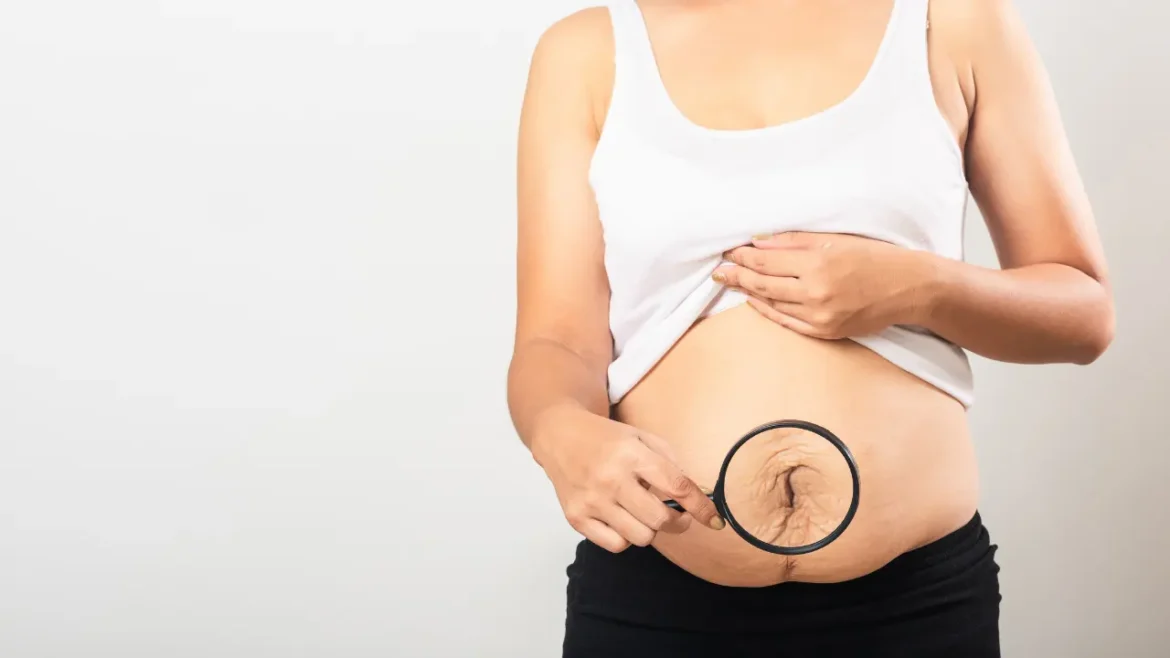Description
Stretch marks, often referred to as striae, represent a common skin disorder distinguished by thin, elongated lines or streaks on the skin’s outermost layer. Pregnancy, puberty ,and periods of significant weight gain or decrease can cause stretch marks. Stretch marks can significantly lower someone’s quality of life and lower their sense of self-worth, necessitating the use of efficient treatment alternatives. Stretch marks commonly appear as lines across the skin that are purplish or reddish in color and with time become lighter. The thighs, hips, buttocks, breasts, and abdomen are where they frequently appear. Itching or pain may accompany the affected skin’s appearance, which may appear slightly elevated or indented.
You May Also Like:
DRY SKIN: DESCRIPTION, CAUSES, AND TREATMENT PROTOCOL
5 GREAT WAYS TO REDUCE STRESS AND ELEVATE MOOD WITHOUT ALCOHOL
Stretch marks: Description, Causes, and Treatment Protocol is an original (HealthXWire) article.
Possible Causes
Stretch marks may form as a result of a number of conditions that cause the skin to stretch or contract more than it should. The following are some potential causes behind stretch marks: –
Pregnancy: Owing to the rapid abdominal expansion that occurs as the baby develops, stretch marks are frequently experienced during pregnancy. Owing to hormonal changes during pregnancy, stretch marks may appear on the skin more frequently.
Puberty: Stretch marks can emerge throughout puberty due to the skin soaring during rapid growth spurts. During adolescence, both boys and girls may go through this.
Weight Fluctuations: Stretch marks can form when the skin stretches or shrinks quickly due to fast weight gain or loss. People who have suffered severe weight changes, like weight loss surgery or obesity, may experience it.
Corticosteroid Use: Stretch marks may occur more frequently if oral or topical corticosteroids are used frequently. These drugs may interfere with collagen synthesis and reduce skin suppleness.
Hormonal Changes: Stretch marks are more likely to occur when there are hormonal imbalances, such as those brought on by diseases like Marfan syndrome or Cushing’s syndrome. These hormonal changes may impact collagen formation and skin suppleness.
Genetic Factors: Stretch marks might be genetically predisposed to appearing. A person may be more prone to get stretch marks if their parents or other close family members have had them.
Medical Conditions: Stretch marks may appear more frequently on the skin in several medical diseases that affect the connective tissues, like Ehlers-Danlos syndrome.
Intense Physical Activity: Stretch marks can be the consequence of the skin stretching out because of engaging in strenuous physical activity or weightlifting that causes rapid muscular growth.

Exacerbating and Mitigating Factors
Stretch marks get worse or better for a variety of reasons. These factors consist of: –
Skin Type: Stretch marks can be more common on some skin types. When subjected to quick shrinking or stretching, dry skin, particularly, has less suppleness and is more susceptible to producing stretch marks.
Genetic Predisposition: The probability of getting stretch marks may be higher if there is a family record of them. Stretch marks may be more common in some people due to genetic factors that might affect the structure and suppleness of the skin.
Hormonal Changes: Stretch marks are more likely to form when there are hormonal imbalances, which can happen during pregnancy, adolescence, or due to certain medical illnesses like Cushing’s syndrome.
Weight Changes or Rapid Growth: Stretch marks can develop when the skin is stretched above its elastic limit by abrupt and large weight changes or growth spurts. As mentioned, this frequently takes place during adolescence, pregnancy, or periods of significant weight increase or loss.
The mitigating factors that mitigate stretch marks: –
Balanced Nutrition: A balanced diet full of vitamins, minerals, and other necessary components is crucial for maintaining general skin health. Vitamins C, A, and E, zinc, silicon, and other nutrients help to support collagen formation and increase skin elasticity.
Keeping a Healthy Weight: Stretch marks can be prevented by maintaining a steady and healthy weight. Stretch mark occurrence is reduced by progressive weight gain or decrease since it gives the skin more time to respond.
Hydration: Maintaining skin suppleness requires adequate hydration. Stretch marks are less likely to form when people drink lots of water and use moisturizers to keep their skin hydrated.
Sun Protection: Long-term exposition to ultraviolet (UV) rays can erode the collagen fibers of the skin, increasing the risk of stretch marks. Stretch marks caused by UV radiation can be reduced by using sunscreen and finding shade when outdoors.
Gentle Skin Care: The skin’s inherent moisture can be maintained and avoidance of strong cleansers, heavy rubbing, and extended contact with hot water will help. Gentle skin care regimens safeguard the skin’s health and lower the chance of stretch marks appearing.

Treatment Options
Numerous therapy options and adjunct treatments, like prescription drugs, over-the-counter remedies, and nutritional supplements, are being investigated alongside conventional treatment protocols to increase the effectiveness of these therapies. Several possibilities include the following: –
Silicone Gel Sheets: The application of silicone gel sheets to the skin is done with adhesive sheets. By moisturizing the skin and encouraging the formation of collagen, they aid in flattening and minimizing stretch marks.
Hyaluronic Acid: Stretch marks can be minimized by using hyaluronic acid-containing topical lotions or injections to increase skin hydration and elasticity. Hyaluronic acid encourages collagen synthesis and moisture retention.
Centella Asiatica Extract: Applying Centella asiatica extract topically has demonstrated promise in reducing the visibility of stretch marks. Skin elasticity is increased, and it encourages collagen formation.
Collagen-Stimulating Peptides: Different topical creams or serums may contain peptides, like palmitoyl tripeptide-5. Stretch marks are diminished and skin suppleness is improved thanks to these peptides, which also aid to increase collagen formation.
Nutritional Supplements: Some dietary supplements may promote skin health and perhaps increase the effectiveness of stretch mark therapies that are currently used. They consist of the following: –
- Vitamin C
In order to maintain healthy skin, vitamin C is crucial for the creation of collagen. It can be ingested or used topically.
- Vitamin E
Vitamin E, which is well-known for its antioxidant effects, maintains skin health and encourages tissue healing. It may be consumed orally or topically.
- Zinc
Zinc participates in the creation of collagen and supports skin integrity. It may be advantageous to take oral supplements or eat foods high in zinc.
- Silicon
For strong, healthy hair, skin, and nails, silicon is a crucial trace element. Supplements and some foods, including leafy greens, whole grains, and bananas, may contain it.
Before beginning any treatment or using supplements to prevent stretch marks, it is essential to speak with a medical practitioner or dermatologist. Based on your unique circumstances, they can offer individualized guidance and choose the best course of action for you.
Stretch mark treatments made of natural ingredients and herbs may not totally get rid of stretch marks, but they can certainly assist with look and skin health. Following are some herbal and natural treatments for stretch marks that are frequently used as supplemental therapy: –
- Aloe Vera
Aloe vera gel offers calming and restorative qualities that can help maintain healthy skin. Stretch marks may look less noticeable and the skin may become more hydrated by using natural aloe vera gel straight to the troubled regions.
- Cocoa Butter
Stretch marks can often be treated naturally with cocoa butter. It is emollient and high in antioxidants, both of which may assist in nourishing the skin. The skin can stay hydrated and flexible by using cocoa butter on the affected regions.
- Coconut Oil
Coconut oil is well known for its ability to moisturize. Stretch marks can be minimized by using virgin coconut oil on the regions affected on a regular basis to assist with skin hydration and suppleness.
- Vitamin E Oil
Vitamin E has become popular for its antioxidant abilities and ability to enhance skin health. Putting vitamin E oil directly on stretch marks can hydrate the skin, encourage healing, and decrease the visibility of scars.
- Gotu Kola
The herb gotu kola, additionally known by the scientific name Centella asiatica, has long been used to promote skin health. It is thought to increase skin elasticity and collagen formation. Stretch marks may be less noticeable when individuals use topical treatments incorporating gotu kola extract or take gotu kola supplements.
- Rosehip Oil
Rosehip oil has antioxidants and vital fatty acids that help nourish one’s skin and encourage skin regrowth. Stretch marks could appear better if you regularly apply rosehip oil to the affected regions.
- Lemon Juice
The natural skin-lightening and exfoliating benefits of lemon juice are well known. Applying some freshly squeezed lemon juice to stretch marks and letting them sit for a few minutes before rinsing will help them appear less apparent.
However, it is crucial to remember that different people may experience different results from using natural and herbal medicines. It is recommended to see a dermatologist or healthcare professional before using any of the herbal or natural therapies, especially for those who have underlying medical concerns, are breastfeeding, or are pregnant.

Conclusion
Stretch marks are medically known as striae and its most easily identified with visible lines or streaks on the skin. They typically form when the skin undergoes rapid stretching or contracting, often if you have growth spurts, weight fluctuations, or are experiencing pregnancy. Although stretch marks are generally harmless, they can impact one’s confidence and body image. Some treatment options are present to improve the appearance of stretch marks which include topical creams with hyaluronic acid, centella asiatica extract, and collagen-stimulating peptides.
It’s important to recognize that the effectiveness of these treatments may vary and the susceptibility of one getting stretch marks also varies based on skin types and genetic predisposition. Adopting a healthy lifestyle that involves maintaining a balanced diet, staying hydrated, and engaging in regular exercise can also promote overall skin health and hence prevent the occurrence of stretch marks. Seeking professional guidance and exploring suitable treatment options can help you feel more self-assured and comfortable in your skin.

Additional resources for further reference
https://www.aad.org/public/cosmetic/scars-stretch-marks/stretch-marks-why-appear
https://www.mayoclinic.org/diseases-conditions/stretch-marks/symptoms-causes/syc-20351139
https://www.medicalnewstoday.com/articles/283651
https://www.webmd.com/beauty/what-are-stretch-marks
Important Note: The information contained in this article is for general informational purposes only, and should not be construed as health or medical advice, nor is it intended to diagnose, prevent, treat, or cure any disease or health condition. Before embarking on any diet, fitness regimen, or program of nutritional supplementation, it is advisable to consult your healthcare professional in order to determine its safety and probable efficacy in terms of your individual state of health.
Regarding Nutritional Supplements Or Other Non-Prescription Health Products: If any nutritional supplements or other non-prescription health products are mentioned in the foregoing article, any claims or statements made about them have not been evaluated by the U.S. Food and Drug Administration, and such nutritional supplements or other health products are not intended to diagnose, treat, cure, or prevent any disease.
Table of Contents


